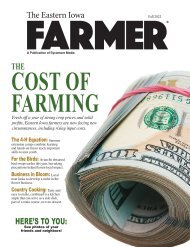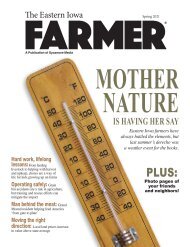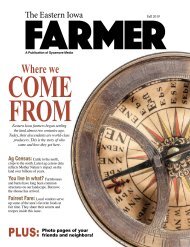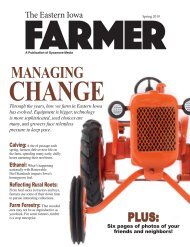Eastern Iowa Farmer Fall 2020
Create successful ePaper yourself
Turn your PDF publications into a flip-book with our unique Google optimized e-Paper software.
STICKLEY<br />
ELECTRIC<br />
THE RIGHT<br />
FIT FOR<br />
ALL YOUR<br />
ELECTRICAL<br />
FARM<br />
NEEDS<br />
Stickley<br />
Electric<br />
Service, Inc.<br />
563-652-2439<br />
Fax: (563) 652-2430<br />
113 Western Ave.,<br />
Maquoketa, IA<br />
growth released, with the role<br />
of top predator vacated by the<br />
loss of our cat, the swallow<br />
population exploded to the<br />
point of public nuisance, a<br />
proper unvoiced but eloquent<br />
eulogy for the unique role<br />
played by our dear departed<br />
cat who could both strategize<br />
bird hunting techniques and<br />
avoid ambuscades and frontal<br />
assaults by another top predator,<br />
our dog.<br />
Now, this year the burgeoning<br />
swallow population has<br />
been replaced (thus far) by a<br />
rag-tag riot of quarrelsome<br />
English sparrows who have<br />
spurned the artistically designed<br />
barn swallow nests for<br />
their own tattered and unkempt<br />
nests drooping distastefully,<br />
almost parasitically, from<br />
the smooth, wooden pinned<br />
elegant frame of timbers that<br />
provides support not only<br />
for the barn but also for their<br />
thrown-together nests. One or<br />
two swallows still sit perched,<br />
perplexed and confused, wondering<br />
what happened to the<br />
old neighborhood.<br />
The wooden framework of<br />
timbers that the bird population<br />
find so convenient for<br />
their nests is truly a wonder<br />
in itself. We marvel at the<br />
carpentry and joinery skills<br />
needed to hew the oak support<br />
beams for the weight of the<br />
overhead storage spaces and<br />
to construct the interlocking,<br />
braced mortise and tenon<br />
joints secured by wooden<br />
pins, and we suspect that those<br />
skills must fade back into the<br />
mists of time. And indeed they<br />
do. Those skills can be traced<br />
directly back to the time of<br />
the first farmers in Europe,<br />
between 8,000 and 7,000<br />
years ago. The three-bayed<br />
pole barn is a form of the long<br />
house that those early farmers<br />
learned to build from the vast<br />
timber lands of central and<br />
western Europe.<br />
Even in our day, it gives<br />
pause to consider that the early<br />
settlers of Wright’s Corners,<br />
just south of Maquoketa, in<br />
old barns<br />
the l840s had to tend fires at<br />
night to fend off marauding<br />
wolves from their flocks of<br />
sheep valuable, in those twilight<br />
days of homespun, more<br />
for their wool than their meat.<br />
The long houses of those<br />
early European farmers, constructed<br />
generally with three<br />
bays with two rows of poles to<br />
support the roof, were among<br />
the largest wooden buildings<br />
anywhere in the world. They<br />
were oriented to the southeast<br />
and periodically burned<br />
every three generations or<br />
so, perhaps to control vermin<br />
or perhaps for ritual reasons<br />
marking the passage of the<br />
generations; no one knows<br />
why exactly.<br />
These early farmers also<br />
constructed wooden wells,<br />
which still survive, surprisingly,<br />
in their waterlogged<br />
condition. Parts of Europe<br />
have available sequences of<br />
tree rings which can be used<br />
to date wood going back<br />
almost to the Ice Age, and the<br />
oak timbers of these wells can<br />
be dated to the precise years<br />
that they were cut, all before<br />
5000 B.C. These well timbers<br />
were shaped into planks<br />
and the wells were built with<br />
interlocking log-cabin style<br />
joints and also with mortise<br />
and tenon joints locked with<br />
wooden cog pins.<br />
Think of it: this work was<br />
done 2000 years or so before<br />
metal tools, using instead polished<br />
stone axes and adzes and<br />
bone chisels. It puts the vaunted<br />
traditions of the stonework<br />
of the freemasons to shame, at<br />
least in terms of age.<br />
And yet many of these old<br />
barns have been abandoned.<br />
But not entirely. Left to fall<br />
prey to nature and the weather<br />
means only that we humans<br />
have left — other opportunists<br />
have moved in.<br />
No longer burdened with<br />
the baleful stress of human<br />
proximity, groundhogs, and<br />
even the occasional badger,<br />
move in to merrily dig and<br />
stake claim under foundation<br />
30 <strong>Eastern</strong> <strong>Iowa</strong> <strong>Farmer</strong> | fall <strong>2020</strong> eifarmer.com
















